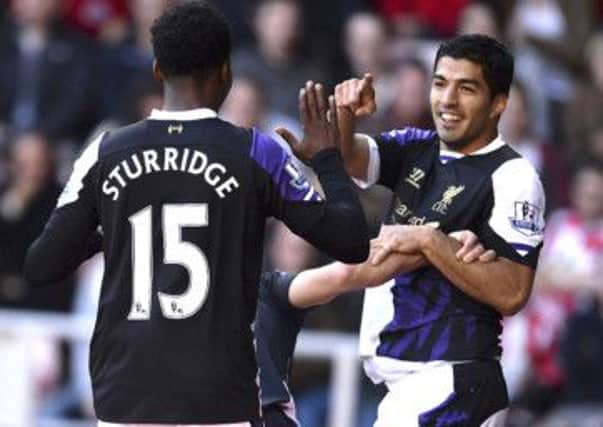4-4-2 formation: it’s the way forward


Clarets boss Sean Dyche is an advocate of revolutionising old-fashioned values in football; modernising tried and tested traits, training methods and structures to find success.
One of those moves has been to implement a version of the formerly championed 4-4-2 formation, which seemingly faced extinction for a decade-or-so, with tacticians finding it inconceivable to prosper with two at the top.
Advertisement
Hide AdAdvertisement
Hide AdFor me, strike partnerships formulate a real sense of nostalgia. It was an obsession that stemmed from Burnley’s Fourth Division championship campaign of 1991/92, engineered by the chemistry of Mike Conroy and Roger Eli.
I remember Eli’s hat-trick against Chesterfield, that diving header past Peter Shilton in the FA Cup, and Conroy dismantling Gillingham on his way to becoming the first Claret since Willie Irvine to score 20 goals in a season.
At Turf Moor, we’ve seen Andy Cooke partner Kurt Nogan, Paul Barnes and Andy Payton; Ian Moore has combined with Gareth Taylor and Robbie Blake, we’ve had Martin Paterson and Steven Thompson, Jay Rodriguez and Charlie Austin, and now we’re excelling in the Championship with the division’s most potent partnership of Danny Ings and Sam Vokes.
Partnerships provide a time, a team, a trophy and a generation with an identity. Ferenc Puskas and Alfredo Di Stefano, Pele and Jairzinho, Eusebio and Jose Augusto Torres, entertained spectators in the past, and also educated and inspired coaches today.
Advertisement
Hide AdAdvertisement
Hide AdBob Paisley, Joe Fagan and Kenny Dalglish all adopted a forward pairing in their respective famed teams of the ‘70s and ‘80s. Kevin Keegan (20) and John Toshack (13) brought the league and European Cup to Anfield in 1977, Ian Rush (47) and Dalglish (12) fired the Reds to the treble in the 1983/84 campaign, while Rush (33) was paired up with Paul Walsh (18) for the 1985/86 league and FA Cup winning term.
And Sir Alex Ferguson utilised the same framework as Andy Cole (24) and Dwight Yorke (29) sparked a historic season for the club as Manchester United won the treble in 1998/99.
Internationally, with the link-up of Gary Lineker and Peter Beardsley coming just before my time, the iconic pairings that were prominent during my football upbringing included Terry Venables’s England and the prolific pairing of Alan Shearer and Teddy Sheringham. The one clash that stands out personally, was the 4-1 thrashing of Guus Hiddink’s Holland in the group stages of Euro 96 with the front two scoring two apiece.
There was Chile’s Ivan Zamorano and Marcelo Salas, Germany’s Jurgen Klinsmann and Rudi Voller, Ronaldo’s pairings with Romario, Bebeto and Rivaldo for Brazil, and Italy’s Filippo Inzaghi and Alessandro Del Piero, among others.
Advertisement
Hide AdAdvertisement
Hide AdThe Premier League has also been bestowed with a selection of clinical and revered partnerships, with Cole and Beardsley starting the trend at Newcastle United just after its inauguration.
Sheringham and Klinsmann and Shearer and Chris Sutton followed, and that inspired a fruitful breed including Robbie Fowler and Stan Collymore, Shearer and Les Ferdinand, Niall Quinn and Kevin Phillips, Thierry Henry and Dennis Bergkamp, Eidur Gudjohnsen and Jimmy Floyd Hasselbaink and Ruud Van Nistelrooy and Ole Gunnar Solskjaer.
After 4-2-3-1 became the default around Euro 2008, Didier Drogba and Nicolas Anelka broke the mould intermittently on a domestic front, but now we’re seeing it back in full force.
Now we’re blessed with Sergio Aguero and Alvaro Negredo or Edin Dzeko at Manchester City, Luis Suarez and Daniel Sturridge at Liverpool and Wayne Rooney and Robin Van Persie at Manchester United, though the latter seems destined to fall under a 4-2-3-1 under David Moyes.
Advertisement
Hide AdAdvertisement
Hide AdAbroad there’s PSG’s Edinson Cavani and Zlatan Ibrahimovic, Monaco’s Radamel Falcao and Emmanuel Riviere, Atletico Madrid’s Diego Costa and David Villa and Juventus’s Fernando Llorente and Carlos Tevez.
Even at Championship level, strike duos are giving opposition food for thought. Away from Ings and Vokes - who have 40 goals between them - Leicester City’s David Nugent and Jamie Vardy have catapulted the club toward the Premier League. And there’s Adam Le Fondre and Pavel Pogrebnyak who have boosted Reading in to play-off contention.
In the modern day, with interpretation and application pivotal, the 4-4-2 formation provides a smoother transition from attack to defence, and vice-versa, while offering a greater provision for unlocking defensive quartets.
As Jonathan Wilson outlined in the Guardian, when it’s two versus one in favour of defence, the spare man is able to provide cover or become a de facto playmaker, instrumenting play from deep.
Advertisement
Hide AdAdvertisement
Hide AdIn a two versus two scenario, that isn’t possible, and on occasions can disrupt the rearguard, with it necessary for a full back to provide cover. But, even if the opposition packs the midfield with five, as has been the case at Turf Moor this season, one striker can drop to sit on the holding player, ultimately mitigating his role while the midfield four provide a sturdy structure. Dyche, and others across the globe, have showcased its success this term, with the majority set to reap the rewards on the back of it.